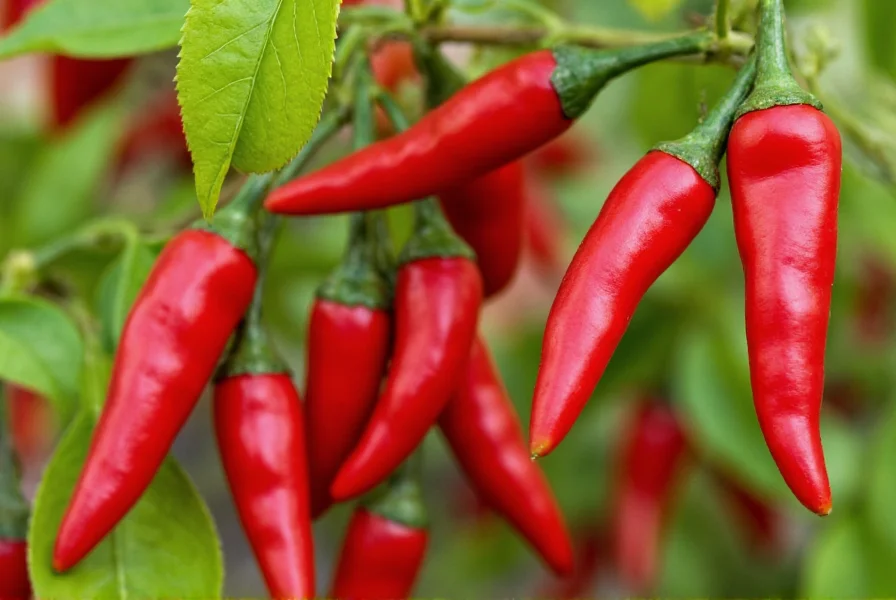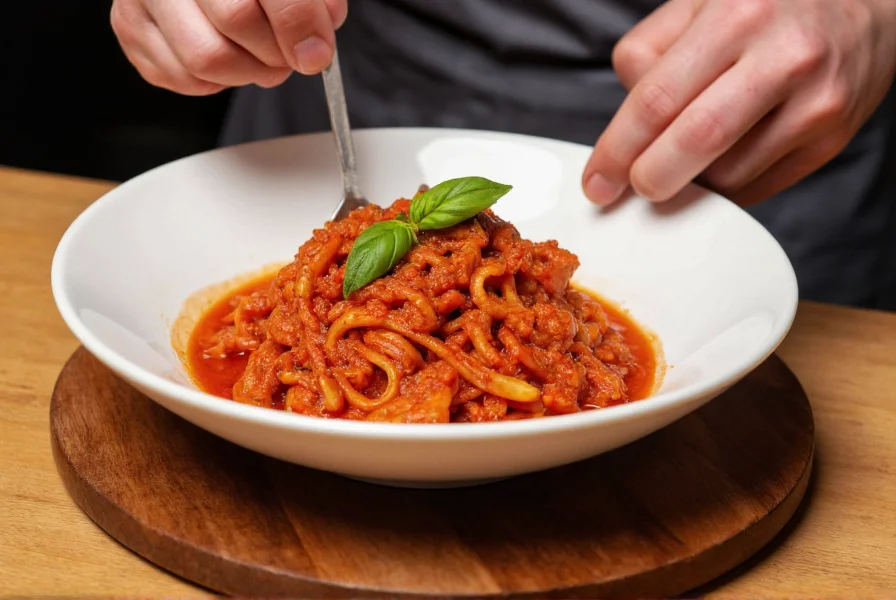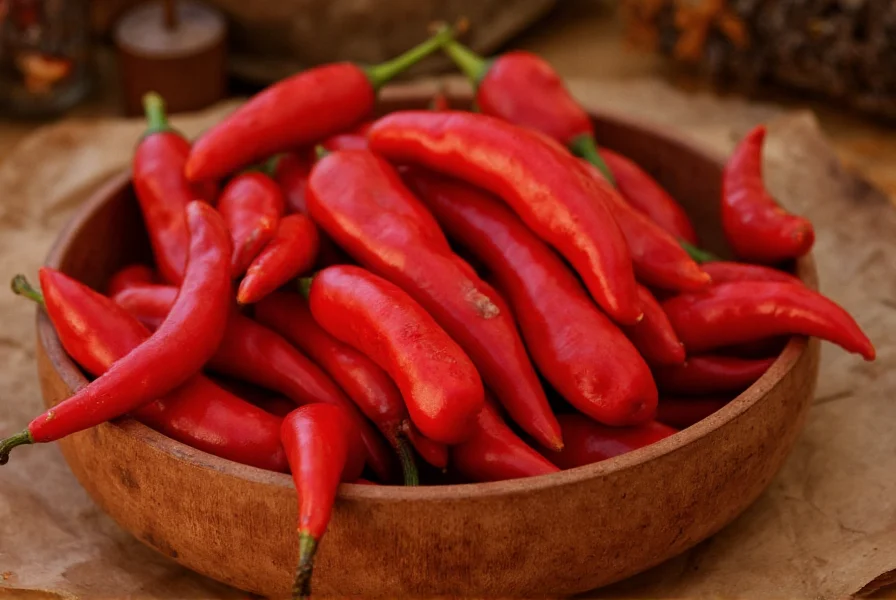These distinctive Italian peppers have gained international popularity among food enthusiasts seeking authentic Mediterranean flavors. Unlike generic red pepper flakes, Calabrian chilies offer a complex flavor profile that enhances dishes without overwhelming heat. Their unique characteristics make them a prized ingredient in both traditional Calabrian cuisine and modern culinary creations worldwide.
Understanding Calabrian Chili Pepper Characteristics
Calabrian chilies (peperoncino calabrese) belong to the Capsicum annuum species and grow abundantly in the sun-drenched hills of southern Italy's Calabria region. These slender, tapered peppers typically measure 2-3 inches in length and transition from bright green to deep crimson as they mature.
What truly distinguishes Calabrian chili peppers from other varieties is their balanced heat profile. Ranking between 25,000-35,000 Scoville Heat Units, they sit comfortably between jalapeños (2,500-8,000 SHU) and cayenne peppers (30,000-50,000 SHU). This moderate heat level allows their nuanced flavor to shine through rather than simply delivering intense spiciness.

Flavor Profile and Culinary Applications
The flavor complexity of Calabrian chili peppers makes them particularly valuable to chefs and home cooks. They offer:
- A distinct fruity undertone with hints of red berries
- Subtle smokiness even when fresh
- Earthy, slightly sweet notes that develop when dried
- A clean heat that builds gradually rather than overwhelming
Traditional Calabrian preparation methods significantly influence how these peppers are used in cooking. The most common commercial forms include:
| Form | Preparation Method | Best Culinary Uses |
|---|---|---|
| Dried whole | Air-dried in sunlight | Infusing oils, grinding into flakes |
| Crushed flakes | Dried then crushed | Pasta dishes, pizza, breads |
| Paste ('nduja) | Fermented with pork fat | Spreading on bread, melting into sauces |
| Preserved in oil | Whole or chopped in olive oil | Salad dressings, marinades, finishing oil |
Historical Significance in Calabrian Cuisine
Chili peppers arrived in Italy following Columbus's voyages to the Americas, but Calabria embraced them more enthusiastically than other Italian regions. By the 18th century, peperoncino had become integral to Calabrian food culture, transforming local cuisine with its vibrant heat.
The mountainous terrain and Mediterranean climate of Calabria create ideal growing conditions for these peppers. Local farmers traditionally harvest Calabrian chilies in late summer through early autumn, then preserve them using time-honored methods that maintain their distinctive flavor profile throughout the year.
One of the most celebrated Calabrian specialties featuring these peppers is 'nduja—a spicy, spreadable pork salume blended with Calabrian chili paste. This unique preparation showcases how deeply embedded these peppers are in regional culinary traditions.
Using Calabrian Chili Peppers in Your Cooking
When incorporating Calabrian chili peppers into your cooking, consider these professional tips:
For dried Calabrian chili flakes: Add early in the cooking process to mellow the heat and allow flavors to infuse. These work particularly well in tomato-based sauces, where the acidity complements the pepper's fruitiness.
For Calabrian chili paste: Use as a finishing element to preserve its vibrant flavor. Stir a teaspoon into mayonnaise for a quick sandwich spread, or swirl into soups just before serving.
For whole preserved peppers: Remove seeds for milder heat, or include them for maximum spice. Chop finely and add to salad dressings or compound butters.

Substitutes and Comparisons
When authentic Calabrian chilies aren't available, these alternatives can approximate their flavor profile:
- Cherry peppers - Similar fruitiness but milder heat (8,000-10,000 SHU)
- Guajillo peppers - Comparable berry notes with less heat (2,500-5,000 SHU)
- Marshall's Delight peppers - Closest heat level with similar flavor complexity
- Combination approach - Mix cayenne (for heat) with a touch of smoked paprika (for depth)
Unlike generic red pepper flakes which often feature cayenne or other single-variety peppers, authentic Calabrian chili products deliver a more complex flavor experience that enhances rather than dominates dishes.
Storage and Handling Recommendations
To maintain the quality of Calabrian chili peppers:
- Store dried flakes in airtight containers away from light and heat
- Refrigerate opened jars of preserved peppers in oil
- Freeze whole peppers for long-term storage (up to 1 year)
- Wear gloves when handling fresh peppers to avoid skin irritation
- Always start with small amounts and adjust to taste—heat can intensify during cooking
Proper storage preserves the delicate balance of fruitiness and heat that makes Calabrian chilies special. Exposure to air, light, or moisture can degrade their distinctive flavor profile over time.
Frequently Asked Questions
Are Calabrian chili peppers hotter than regular red pepper flakes?
Calabrian chili peppers typically range from 25,000-35,000 Scoville units, making them moderately hot—hotter than paprika but milder than cayenne. Most commercial red pepper flakes use cayenne as the primary ingredient (30,000-50,000 SHU), so authentic Calabrian chilies generally provide a more balanced heat with greater flavor complexity.
What makes Calabrian chili peppers different from other Italian peppers?
Calabrian chilies are distinguished by their unique terroir—growing in Calabria's specific Mediterranean climate and mineral-rich soil. This produces peppers with a distinctive fruity, slightly sweet profile with subtle berry notes alongside their moderate heat, unlike the one-dimensional heat of many other Italian pepper varieties.
How can I use Calabrian chili paste in everyday cooking?
Calabrian chili paste adds instant depth to numerous dishes. Stir a teaspoon into mayonnaise for sandwiches, whisk into vinaigrettes, swirl into tomato sauces, or mix with olive oil as a bread dip. Its versatility makes it ideal for elevating simple dishes like roasted vegetables, pasta, or even scrambled eggs with minimal effort.
Are Calabrian chili peppers the same as 'nduja?
No, they're related but distinct. Calabrian chili peppers refer to the actual peppers, while 'nduja is a specific Calabrian specialty made by blending Calabrian chili paste with pork fat and other seasonings. 'Nduja has a spreadable consistency and complex fermented flavor, whereas Calabrian chili products focus primarily on the pepper itself in various preparations.











 浙公网安备
33010002000092号
浙公网安备
33010002000092号 浙B2-20120091-4
浙B2-20120091-4